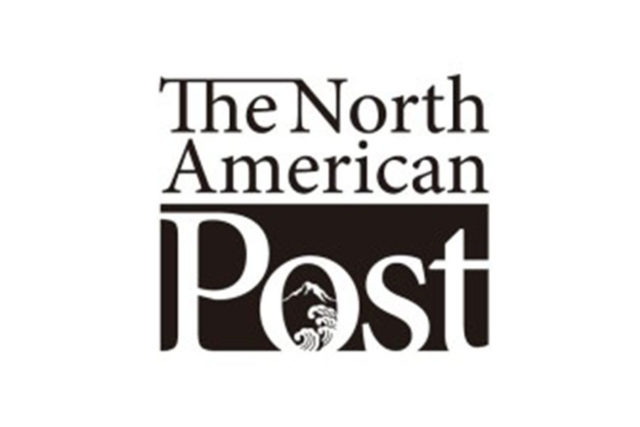By Yukiko Tanaka
For The North American Post
Tsukiji is not just about the fish market, although it attracts a great deal of visitors all year round. A Buddhist temple in a large stone building known as Tsukiji Honganji is there as well. The area behind the temple and to northeast along the bank of Sumida River is the neighborhood of Akashicho. It is less known today, but the area was a vibrant neighborhood long before Tsukiji Market opened.
At the center of Akashi-cho is St. Luke Hospital, which opened its doors in the 7th year of Meiji. A clinic started by an American missionary that treated the poor free of charge, it grew into a hospital and a school to train nurses a few decades later. Except for the ten years of US occupation after the Pacific War, it has been treating patients seeking its medical care beyond Tokyo as it is known as an excellent medical facility. The hospital building we see today is new, but the nursing school is original.
During the years when Japan opened its doors to the outside world, ending the Edo regime (around the 1870s), the neighborhood where St. Luke hospital now stands was very vibrant. Foreign ships, mostly American and British, came to trade under the treaty introduced by the new government. They sailed into Tokyo Bay and anchored nearby. Soon merchants of those countries set up their businesses and lived in the neighborhood. Akashi-cho, in other words, was an area of foreign concession. Today, however, we see nothing that belongs to that time except for a few bricks used for buildings. In the former concession site now stands a primary school, and at the corner of its playground stands a gas streetlight modeled after the original one.
It is extremely difficult to imagine what a day was like here, in Akashi-cho, two hundred fifty years ago. Nonetheless, you can try to imagine with the help of a few markers on which are written brief explanations telling what had been there. You can find, for instance, one indicating that Keio-gijuku (today’s Keio University) opened its door here. An official residence of Nakatsu Domain was located here and Fukuzawa Yukichi, the founder of Keio University, who belonged to that domain, is the reason for the small private school having started here.
Another feudal lord who had his Edo residence in this neighborhood is Lord Asano of Ako Domain. The story of forty-seven samurai avenging their master is widely known, making its way into the Kabuki stage and stories and even known abroad as well. Those samurai are of Ako Domain and you will find, if you try, the marker that indicates the remarkable incident actually took place in the late 17th century.
The forty-seven samurai, both high-ranking and those at the bottom of the feudal hierarchy, walked as a group from Honjo, where the avenged resided, to Sengaku-ji Temple, their lord’s burial place. On the way to their destination they stopped and rested at their domain’s estate in Akashi-cho; the walk took several hours altogether.
Honjo is on the other side (east) of Sumida River, so the group walked southward first to cross the river on Eitai Bridge. After they stopped at Akashi-cho briefly, they took a route westward behind Tsukiji Hongan-ji. Heading south on Tokaido (the main highway west as far as Osaka), they reached their destination having walked through Tamachi and Takanawa (in Minato Ward).
Walking the route taken by the forty-seven samurai has been a popular pastime for some Tokyoites. I do not know how long it would actually take, but I heard that people use an Edo picture map to orient themselves. Despite the fact that not much from the old time has remained in Tokyo today, this is possible because present-day boundaries of wards, often a meandering line, were where old streets, canals and rivers were. Historically significant places in Tokyo’s neighborhoods have been of great interest as of late, particularly among retired seniors. You might spot one or two people like this walking around various neighborhood with a map in hand.
Ten minutes north of Akashi-cho on foot, you are in an enclave called Teppozu (teppo is gun, zu is a port). A few cannons, given by the Dutch government, were set here shortly after the shogun’s government made treaties with the Americans and the British. Having been rudely awakened by the arrival of the “black ships”–a fleet of iron (thus black) ships led by Commodore Perry, the Japanese were at a loss. There was a minor military confrontation with Britain as well. Japanese leaders with different backgrounds and beliefs were in two factions: for and against opening their country to outside forces. In dealing with foreign diplomats and merchants, men like Sakamoto Ryoma and Katsu Kaishu, both eager to build new Japan by introducing western ideas and systems as well as commercial exchanges, walked around here in Teppozu.
After all disappeared and turned into mere marker posts, today’s Akashi-cho is a quiet residential neighborhood with apartments and a playground. What remains of the pre-WWII structure around here besides the nursing school by St. Luke Hospital is a tiny store called Kagohei making and selling bamboo baskets, some to Tsukiji Fish Market.
[Editor’s Note]
This series will be published every week. The writer can be reached atytanaka03@gmail.com.








